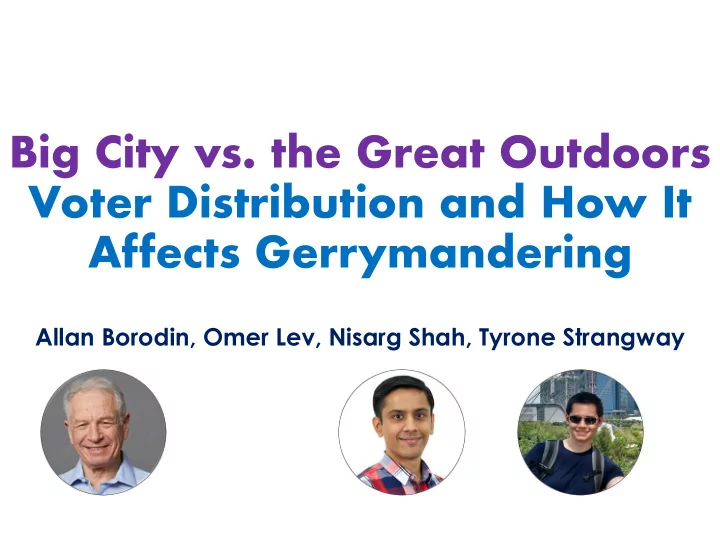

Big City vs. the Great Outdoors Voter Distribution and How It Affects Gerrymandering Allan Borodin, Omer Lev, Nisarg Shah, Tyrone Strangway
Gerrymandering
Gerrymandering
Gerrymandering
Gerrymandering proportional
Gerrymandering Red
Gerrymandering blue
Gerrymandering complexity Open question: Is dividing a planar graph into 2 equal sized connected components NP-hard? (Dyer and Frieze 1985 show NP-hard for general graphs, and hypothesize same in planar case)
Goals Prevent gerrymandering!!
Goals Prevent gerrymandering!!
Goals Prevent gerrymandering!! Detect gerrymandering!!
Goals Prevent gerrymandering!! Detect gerrymandering!!
Goals Prevent gerrymandering!! Detect gerrymandering!! Study the effect of voter distribution on gerrymandering
Gerrymandering power The difference between the number of districts a party should have , under a fairness criterion (e.g., proportional to its support size ) and the maximal number of districts it can get under optimal gerrymandering .
Homogenous population
Recently… US (2016) 48.04% 45.95% Popular vote:
US 2016 results, geography
US 2016 results, geography & population
Recently… UK (2010) 36.1% 29% Popular vote: 39.69% 47.08% MP share:
UK 2010 results, geography
UK 2010 results, geography & population
Continuous grid For voter densities " 1 and " 2 : For worst case: a sharp transition at 50% (in best case, can’t achieve more than double their voter share) Best case Seat share → Worst case Vote share →
Discrete grid For 2 districts ! " + ! $ voting share guarantees winning both districts
Urban / rural divide
Urban / rural divide
Urban / rural divide
Optimal Gerrymandering Urban Rural optimal optimal share share ~44:56 ~66:34 Vote Share 55:45
Urban / rural divide urban=40%;rural=60%
Urban / rural divide
What’s next? Extend theory : larger grids different voter distributions More variables , more explanation power Data, data, DATA ! More robust simulations Suburb /exurb effect? Axiomatic approach?
The End Thanks for listening!
Recommend
More recommend